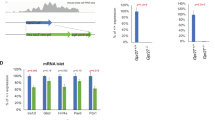Abstract
Null mutations in the glucokinase (GCK) gene can cause autosomal dominant type 2 diabetes (maturity onset diabetes of the young, MODY); however, MODY is genetically heterogeneous. In both liver and pancreatic islet, glucokinase is subject to inhibition by a regulatory protein (GCKR). Given the role of GCK in MODY, GCKR is itself a candidate type 2 diabetes susceptibility gene. Here we describe the structure of full-length (2.2 kb) cDNA for human GCKR, from the hepatoblastoma cell line HepG2. The human GCKR translation product has 625 amino acids and a predicted molecular weight of 68,700. It has 88% amino acid identity to rat GCKR. Yeast artificial chromosomes (YAC clones) containing human GCKR were isolated, and the gene was mapped to Chromosome (Chr) 2p23 by fluorescent in situ hybridization and somatic cell hybrid analysis.
Similar content being viewed by others
References
Anand, R., Riley, J.H., Butler, R., Smith, J.C., Markham, A.F. (1990). A 3.5 genome equivalent multi-access YAC library: construction, characterisation, screening and storage. Nucleic Acids Res. 18, 1951–1956.
Bell, G.I., Xiang, K.S., Newman, M.V., Wu, S.H., Wright, L.G., Fajans, S.S., Spielman, R.S., Cox, N.J. (1991). Gene for non-insulin-dependent diabetes mellitus (maturity onset diabetes of the young subtype) is linked to DNA polymorphism on human chromosome 20q. Proc. Natl. Acad. Sci. USA 88, 1484–1488.
Bonthron, D.T., Brady, N., Donaldson, I.A., Steinmann, B. (1994). Molecular basis of essential fructosuria; molecular cloning and mutational analysis of human ketohexokinase. Hum. Mol. Genet. 3, 1627–1631.
Detheux, M., Vandekerckhove, J., Van Schaftingen, E. (1993). Clonging and sequencing of rat liver cDNAs encoding the regulatory protein of glucokinase. FEBS Lett. 321, 111–115 (correction in FEBS Lett. 339, 312–315).
Devereux, J., Haeberli, P., Smithies, O. (1984). A comprehensive set of sequence analysis programs for the VAX. Nucleic Acids Res. 12, 387–395.
Froguel, P., Zouali, H., Vionnet, N., Velho, G., Vaxillaire, M., Sun, F., Lesage, S., Stoffel, M., Takeda, J., Passa, P., Permutt, M.A., Beckmann, J.S., Bell, G.I., Cohen, D. (1993). Familial hyperglycemia due to mutations in glucokinase. Definition of a subtype of diabetes mellitus. N. Engl. J. Med. 328, 697–702.
Kozak, M. (1987). An analysis of 5′-noncoding sequences from 699 vertebrate messenger RNAs. Nucleic Acids Res. 15, 8125–8148.
Landegent, J.E., Jansen in de Wal, N., Dirks, R.W., Baao, F., van der Ploeg, M. (1987). Use of whole cosmid cloned genomic sequences for chromosomal localization by non-radioactive in situ hybridization. Hum. Genet. 77, 366–370.
Malaisse, W.J., Malaisse-Lagae, F., Davies, D.R., Vandercammen, A., Van Schaftingen, E. (1990). Regulation of glucokinase by a fructose-1-phosphate-sensitive protein in pancreatic islets. Eur. J. Biochem. 190, 539–545.
Matschinsky, F.M. (1990). Glucokinase as glucose sensor and metabolic signal generator in pancreatic β-cells and hepatocytes. Diabetes 39, 647–652.
Pinkel, D., Strawme, T., Gray, J.W. (1986). Cytogenetic analysis using quantitative, high-sensitivity, fluorescence hybridization. Proc. Natl. Acad. Sci. USA 83, 2934–2939.
Sinclair, K., Warner, J.P., Bonthron, D.T. (1994). The ASP1 gene of Saccharomyces cerevisiae, encoding the intracellular isozyme of L-asparaginase. Gene 144, 37–43.
Van Schaftingen, E. (1989). A protein from rat liver confers to glucokinase the property of being antagonistically regulated by fructose 6-phosphate and fructose 1-phosphate. Eur. J. Biochem. 179, 179–184.
Vaxillaire, M., Vionnet, N., Vigouroux, C., Sun, F., Espinosa, R., Lebeau, M.M., Stoffel, M., Lehto, M., Beckmann, J.S., Detheux, M., Passa, P., Cohen, D., Van Schaftingen, E., Velho, G., Bell, G.I., Froguel, P. (1994). Search for a third susceptibility gene for maturity-onset diabetes of the young: studies with eleven candidate genes. Diabetes 43, 389–395.
Vaxillaire, M., Boccio, V., Philippi, A., Vigouroux, C., Terwilliger, J., Passa, P., Beckmann, J.S., Velho, G., Lathrop, G.M., Froguel, P. (1995). A gene for maturity onset diabetes of the young (MODY) maps to chromosome 12q. Nature Genet. 9, 418–423.
Veiga-da-Cunha, M., Detheux, M., Watelet, N., Van Schaftingen, E. (1994). Cloning and expression of a Xenopus liver cDNA encoding a fructose-phosphate-insensitive regulatory protein of glucokinase. Eur. J. Biochem. 225, 43–51.
Author information
Authors and Affiliations
Additional information
EMBL database accession numbers: Z48475 and Z48476.
Rights and permissions
About this article
Cite this article
Warner, J.P., Leek, J.P., Intody, S. et al. Human glucokinase regulatory protein (GCKR): cDNA and genomic cloning, complete primary structure, and chromosomal localization. Mammalian Genome 6, 532–536 (1995). https://doi.org/10.1007/BF00356171
Received:
Accepted:
Issue Date:
DOI: https://doi.org/10.1007/BF00356171




